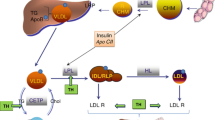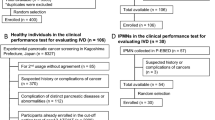Abstract
In 43 normolipidemic postmenopausal women we studied fasting and postprandial (oral fat load with 50 g fat per square meter; blood sampling for 5 h) lipoprotein components and lipoprotein(a) levels before and with the administration of conjugated equine estrogens opposed by medrogestone (on days 11–21). Data was compared intraindividually; the second testing was performed during the last 5 days of the combined estrogen/progestogen phase of the third cycle. Fasting low-density lipoprotein (LDL) and total cholesterol concentrations decreased significantly; high-density lipoprotein (HDL) cholesterol, including subfractions HDL2 and HDL3, was not changed. Fasting triglyceride concentrations increased. All lipoprotein fractions measured showed a postprandial elevation with the exception of chylomicron cholesterol concentrations. There was a significant effect of hormone replacement therapy on the postprandial course of total cholesterol (decrease; P < 0.001), VLDL cholesterol (increase; P = 0.025), and the triglyceride proportion in the LDL plus HDL fraction (increase; P < 0.001). With hormone replacement therapy the postprandial curve of total triglycerides was increased only 1 h after the fat load while chylomicron triglyceride concentrations were lowered after 5 h. VLDL triglycerides were not influenced. In all patients with lipoprotein(a) levels above 10 mg/dl, this parameter decreased (about 25%). Although increasing fasting triglyceride concentrations, hormone replacement therapy does not bring about an exaggerated postprandial increase in triglycerides. Postprandial chylomicron clearance is evidently promoted. Hormone replacement therapy leads to a small increase in triglycerides in the LDL plus HDL fraction by inhibiting hepatic lipase activity. Moreover, the decrease in lipoprotein(a) levels may contribute to the antiatherosclerotic effect.
Similar content being viewed by others
Abbreviations
- CEE:
-
conjugated equine estrogens
- HDL:
-
high-density lipoproteins
- HRT:
-
hormone replacement therapy
- LDL:
-
low-density lipoproteins
- TG:
-
triglycerides
- VLDL:
-
very low density lipoproteins
References
Applebaum-Bowden D, McLean P, Steinmetz A, Fontana D, Matthys C, Warn Cheung M (1989) Lipoprotein, apolipoprotein, and lipolytic enzyme changes following estrogen administration in postmenopausal women. J Lipid Res 30:1895–1906
Barrett-Connor E, Bush TL (1991) Estrogen and coronary heart disease in women. JAMA 265:1861–1867
Berr F, Eckel RH, Kern F (1986) Contraceptive steroids increase hepatic uptake of chylomicron remnants in healthy young women. J Lipid Res 27:645–651
Bruin de TWA, Brouwer CB, Gimpel JA, Erkelens DW (1991) Postprandial decrease in HDL cholesterol and HDL-associated apolipoprotein A-I in normal subjects in relation to the triglyceride metabolism. Am J Physiol 260:E492–498
Cohn JS, McNamara JR, Cohn SD, Ordovas JM, Schaefer EJ (1988) Plasma apolipoprotein changes in the triglyceriderich lipoprotein fraction of human subjects fed a fat-rich meal. J Lipid Res 29:925–936
Darj E, Crona N, Nilsson S (1992) Effects on lipids and lipoproteins in women treated with oestradiol and progesterone. Maturitas 15:209–215
Dupont A, Moorjani S, Cusan L, Dupont P, de Lignieres B, Mailloux J, Gomez JL, Labrie F (1992) Effect of progesterone on cholesterol and lipoproteins during hormone replacement therapy. In: Lobo RA, Naftolin F (eds) Progesterone in hormonal replacement therapy. Parthenon, Carnforth, pp 37–46
Erkelens DW (1993) Man is a postprandial subject and postprandial triglyceride-rich lipoprotein remnants are atherogenic. Nutr Metab Cardiovasc Dis 3:99–101
Groot PHE, van Stiphout WAHJ, Krauss XH, Jansen J, van Tol A, van Rämshorst E, Chin-On S, Hofmann A, Cresswell SR, Havekes L (1991) Postprandial lipoprotein metabolism in normolipidemic men with and without coronary artery disease. Arterioscler Thromb 11:653–662
Haenggi W, Birkhaeuser MH (1993) A new peroral estrogen/progestin combination for postmenopausal hormonal substitution: an open multicentric field study. Maturitas 16:111–122
Karathanasis SK (1992) Lipoprotein metabolism: high-density lipoprotein. In: Lusis AJ, Rotter JI, Sparkes RS (eds) Molecular genetics of coronary artery disease. Candidate genes and processes in atherosclerosis. Monographs Human Genetics, Karger, Basel, pp 140–171
Karpe F, Bard J-M, Carlson GSLA, Fruchart J-C, Hamsten A (1993) HDLs and alimentary lipemia. Studies in men with previous myocardial infarction at a young age. Arterioscler Thromb 13:11–22
Kostner GM, Molinari E, Pichler P (1985) Evaluation of a new HDL2/HDL3 quantitation method based on precipitation with polyethylene glycol. Clin Chim Acta 148:139–147
LaRosa JC (1992) Lipids and cardiovascular disease: do the findings and therapy apply equally to men and women? Womens Health Issues 2:102–113
Leonhardt W, Pietzsch J, Nitzsche S (1994) Very-fast ultracentrifugation of human plasma lipoproteins: influence of the centrifugal field on lipoprotein composition. Clin Chim Acta 224:21–32
Lobo RA (1991) Effects of hormonal replacment on lipids and lipoproteins in postmenopausal women. J Clin Endocrinol Metab 73:925–930
Lobo RA, Notelovitz M, Bernstein L, Khan FY, Ross RK, Paul WL (1992) Lp(a) lipoprotein: relationship to cardiovascular disease risk factors, exercise, and estrogen. Am J Obstet Gynecol 166:1182–1190
Muesing RA, Miller VT, LaRosa JC, Stoy DB, Phillips EA (1992) Effects of unopposed conjugated equine estrogen on lipoprotein composition and apolipoprotein-E distribution. J Clin Endocrinol Metab 75:1250–1254
Nanjee MN, Koritnik DR, Thomas J, Miller NE (1990) Hormone determinants of apolipoprotein B,E receptor expression in human liver. Positive association of receptor expression with plasma estrone concentration in middle aged/elderly women. Biochim Biophys Acta 1046:151–158
Patsch JR, Miesenböck G, Hopferwieser T, Mühlberger V, Knapp E, Dunn JK, Gotto AM, Patsch W (1992) Relation of triglyceride metabolism and coronary artery disease. Studies in the postprandial state. Arterioscler Thromb 12:1336–1345
Seed M (1991) Sex hormones, lipoproteins, and cardiovascular risk. Atherosclerosis 90:1–7
Soma M, Fumagalli R, Paoletti R, Meschia M, Main MC, Crostignam P, Ghanem K, Gaubatz J, Morrisett JDf (1991) Plasma Lp(a) concentration after oestrogen and progestagen in postmenopausal women. Lancet 337:612
Sonnendecker EW, Polakow ES, Benade AJ, Simchowitz E (1989) Serum lipoprotein effects of conjugated estrogen and a sequential conjugated estrogen-medrogestone regimen in hysterectomized postmenopausal women. Am J Obstet Gynecol 160:1128–1134
Stevenson JC, Crook D, Godsland IF (1993) Influence of age and menopause on serum lipids and lipoproteins in healthy women. Atherosclerosis 98:83–90
Van Tol A (1990) Die Rolle der hepatischen Lipase (HTGL), der Cholesterinester-Transfer-Proteine und der LCAT in der postprandialen Phase. Klin Wochenschr 68:23–28
Weintraub MS, Zechner R, Brown A, Eisenberg S, Breslow JL (1988) Dietary polyunsaturated fats of the W-6 and W-3 series reduce postprandial lipoprotein levels — chronic and acute effects of fat saturation on postprandial lipoprotein metabolism. J Clin Invest 82:1884–1893
Windler E, Beil FU, Daerr WH, Greten H (1992) Postprandiale Lipämie und Arteriosklerose. Dtsch med Wochenschr 117:795–800
Windler E, Jäckle S (1993) Induction of the hepatic uptake of lipoproteins by estrogen. In: Steinmetz A, Schneider J, Kaffarnick H (eds) Hormones in lipoprotein metabolism. Springer, Berlin Heidelberg New York, pp 99–105
Author information
Authors and Affiliations
Additional information
Correspondence to: U. Julius
Rights and permissions
About this article
Cite this article
Julius, U., Fritsch, H., Fritsch, W. et al. Impact of hormone replacement therapy on postprandial lipoproteins and lipoprotein(a) in normolipidemic postmenopausal women. Clin Investig 72, 502–507 (1994). https://doi.org/10.1007/BF00207478
Received:
Accepted:
Issue Date:
DOI: https://doi.org/10.1007/BF00207478




